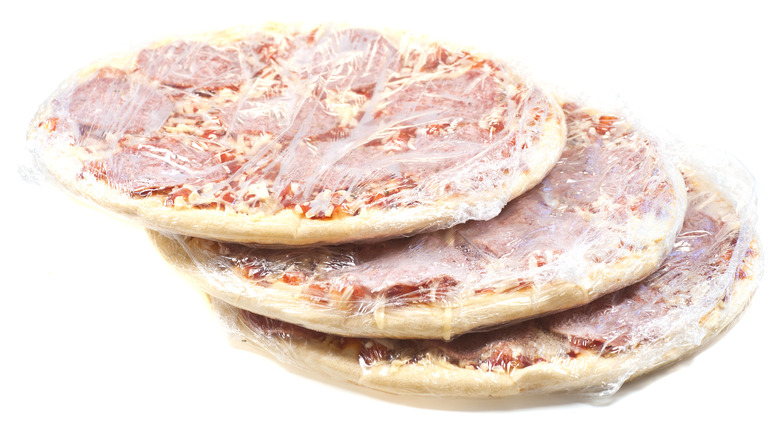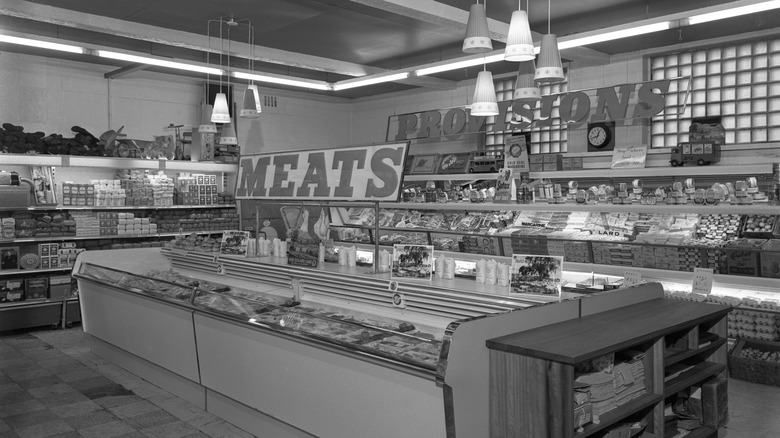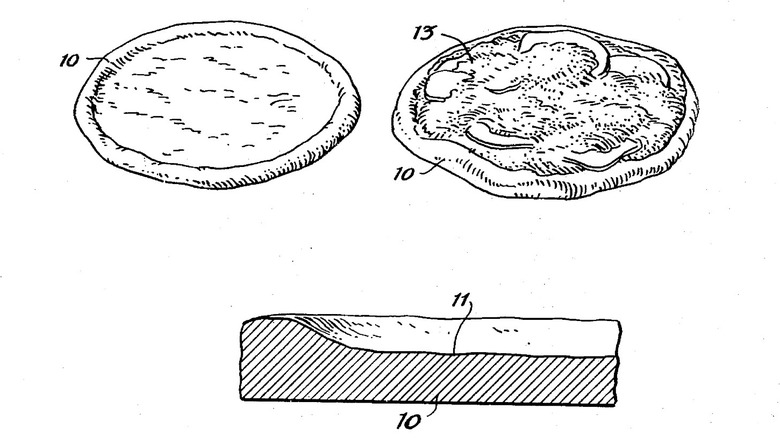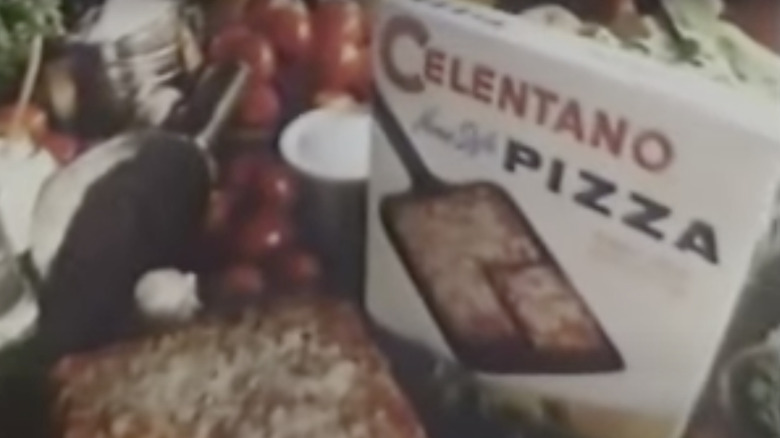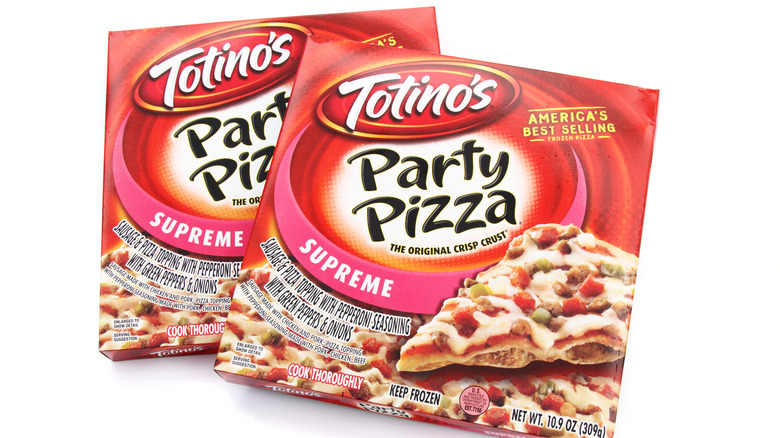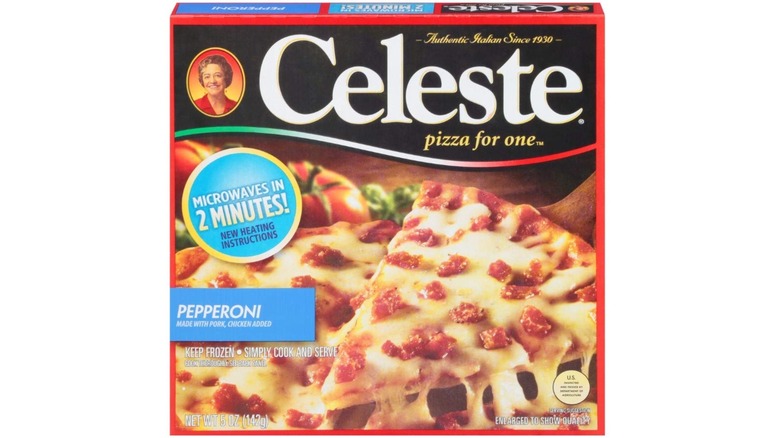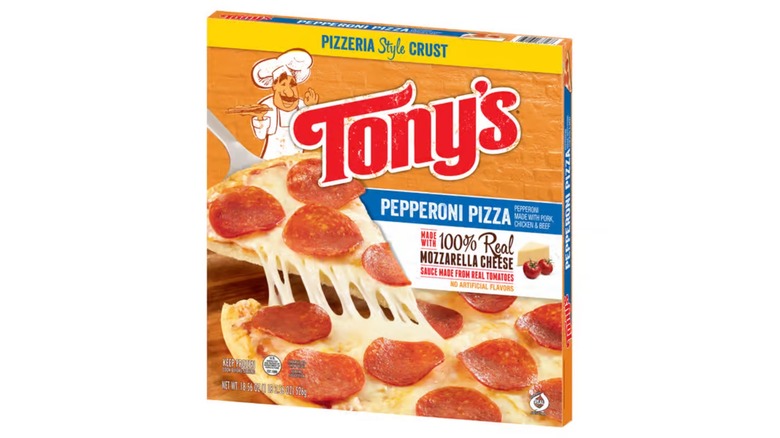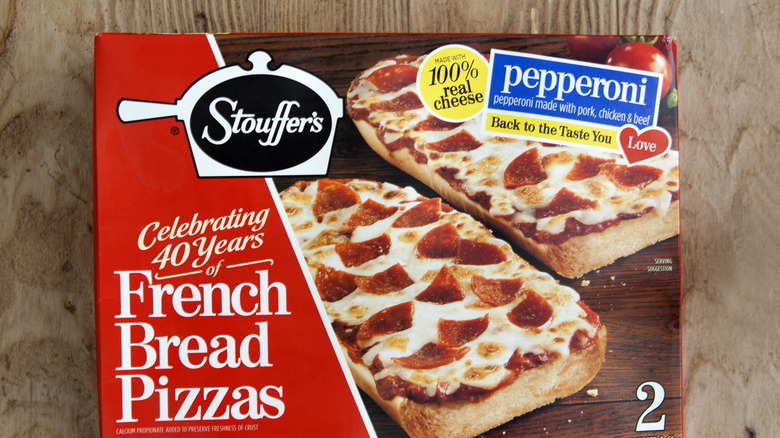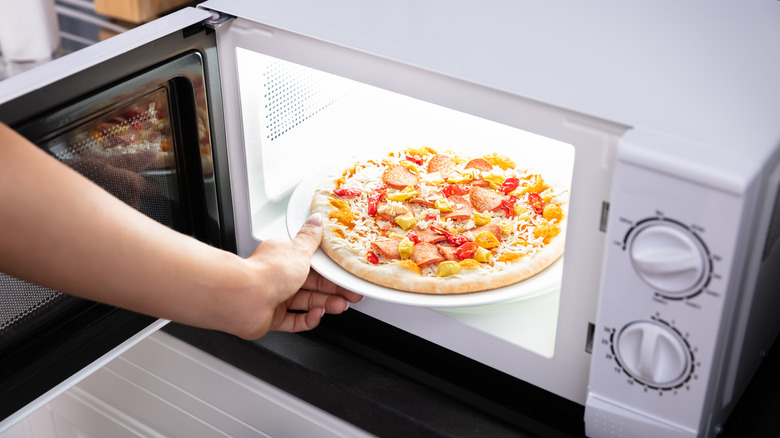The Humble Restaurant Origins Of The Frozen Pizza
Today, frozen pizza generates more than $6.6 billion a year, but it wasn't always a solution for weeknight dinners. People used to have to go to a pizzeria or make it themselves if they wanted a pie, and, in the 1950s, finding a pizzeria wasn't so easy in many parts of the United States. Then, Italian restaurants in urban centers came up with a way to sell their products to a wider audience and increase business: they could freeze their pizzas and ship them regionally. Some of these small family establishments grew into some of the top-selling frozen pizza brands.
The first hint of this practice comes from a New York Times June 1950 headline, "Pizzas Now Offered Here Ready-To-Cook." The blurb describes refrigerated, not frozen, pizzas shipped into the city from Boston's Guiffre's Roma Pizza Company to two or three specialty supermarkets. New Yorkers could pick them up, bake them, and enjoy pizza right out of the oven at home.
Around the same time, the frozen food industry began marketing its products to the middle class instead of only the wealthy. Over the next decade, frozen food would become much cheaper and supermarkets changed their infrastructure to include frozen food sections. At first, the offerings were mostly vegetables, but that changed. To widen the consumer base, frozen food leaders, added prepared foods, like pizza, to the list of their offerings. When they did this, they purchased regional frozen pizza lines produced by family-owned pizzerias.
1952: Frozen pizza makes a splash in Akron, Ohio
In the 1950s, Akron, Ohio was best known as the rubber capital of the world, but it was also home to one of the first frozen pizza lines. All of the money coming in from Goodyear brought on a golden age for Summit County's restaurants. During this decade, these establishments could feed 30,000 people at once — over 10% of its 270,000 residents.
DeLuca's Bismark Restaurant, which had pizza on the menu, was one of the city's many eateries. It opened in 1933 and served the city through the golden epoch of Akron dining out. Anthony "Jack" De Luca was the owner and quite a character by any measure of the word — he even hosted a radio show called "Koffee Kapers," which he broadcast from his locale.
In December 1952, De Luca appeared in an article in The Akron Beacon Journal titled, "Frozen Pizza Business Does OK For De Luca." In the photo, De Luca proudly holds up a stack of frozen pizzas which he said earned him $20,000 a month. At the time of publication, he was already shipping them to Cleveland, Youngstown, and Canton. Pizza was such a niche food, when the piece appeared, that the journalist needed to explain the pronunciation of the dish, "peet-zaa," and describe what it was.
1954: Philadelphia pizzeria patents the process
Freezing pizza presents some problems and early industry pioneers struggled. For example, if you freeze raw dough, it breaks down the gluten and won't fluff up in the oven. On the other hand, if you freeze a pre-baked crust topped with tomato sauce and veggies it will get soggy as it warms up again. Pizza maker, Joseph Bucci, knew this and came up with a way to make higher-quality frozen pizzas.
In 1950, he applied for a patent. Bucci's pizza included an edible sealing agent that he painted on top of the crust before baking — that's a complicated way to say tomato puree, which is what he used. The thin layer of puree which baked with the crust meant that when he added more copious sauce later, it didn't make the crust soggy. He waited for four years until his application for a "Method of making frozen pizza" finally came through.
By 1954, though, frozen pizzas were already getting popular and they weren't Bucci's brand or method. A year earlier, in April 1953, The New York Times said that people could buy quick-frozen pizza at neighborhood grocers, meaning that frozen pizza was firmly in the fast lane to becoming wildly popular.
1957: Newark specialty Italian shop starts preparing frozen pizzas
The Celentano family is a great of the Italian frozen food business. The story begins in the late 1940s when Domenick Celentano visited his mother-in-law. She served store-bought ravioli and Celentano thought he could make superior ones. So, he did, but instead of squares, he cut them into circles. They were a big hit in his Newark shop which also sold Italian products like cheese, sausage, and spices.
Ten years later, in 1957, the Celentanos ventured into the frozen pizza business. It was a logical step considering the ingredients they needed were readily available on their shop's shelves and their existing success with frozen pasta. Their brand was one of the first marketed nationally and they knew how to set it apart from the competition. Rebels from the beginning with their distinctively shaped pasta, the Celentanos snubbed their noses at round pizza, and, instead, sold square ones.
Comments on a YouTube video of a 1980s Celentano's Pizza commercial lament that the product is no longer available, saying it was the best of its kind. When Rosina Foods bought Celentano's company in 2000, it decided to continue with its pasta only. So, although this Italian shop left a lasting mark on the frozen foods section, it hasn't been in the shape of a pizza.
1962: A family pizzeria serves up pies for the masses
Rose Totino and her husband shared her homemade pizza with a loan officer at a Minneapolis bank before getting approval in the early 1950s. The banker didn't know what pizza was beforehand, but he must have liked the product once he tried it because the couple got the loan.
That initial $1,500 loan grew into a brand that currently earns around $960 million a year, but it took a bit of elbow grease to get there. At first, Totino made pizzas for a simple take-out counter, but they were so good, the shop grew into a full-on sit-down restaurant. Suddenly, Totino was making around 400 pizzas a day. That still didn't satisfy the demand for the pies, so she started mass-producing and freezing them. Totino's Finer Foods branched off from the family restaurant in 1962.
Still, Totino's frozen pizzas only reached people in the Midwest. They didn't become a nationwide success until Pillsbury, also from Minneapolis, bought Totino's in 1975. With Totino, a high-school dropout and former housecleaner, as vice president, the company developed and patented the crisp crust. Thus, Totino's Party Pizza, known and loved by many today, was born. Unfortunately, the family restaurant, where this pizza got its start, has not endured as well as the oven-ready pizza. Totino's Italian Kitchen closed in 2011 after being in business for around 60 years.
1962: After 25 years as a pizzeria, a restaurant closed and a pizza factory was born
It's the 1930s and you're a WPA worker in Chicago. Walking home, you pass a little Italian grocer. The smell wafting out of the door is unbelievable, and, so, you have to go in. Celeste Lizio, the owner, is in the back kitchen making the recipes she learned as a girl in Sant'Angelo, near Naples. You beg her to sell you a plate just so you can try whatever it is producing that heavenly smell.
Celeste Lizio may have started as a grocer, but her little shop quickly became Kedzie Beer Garden in 1937 because of her delicious home cooking. Later she changed the name to Celeste's. For the next decade, she labored away in the kitchen producing all sorts of delicacies, including pizza. Then, Lizio's adult children saw that the world was changing. They encouraged their mother to start selling the same dishes but frozen. By 1962, she was so successfully supplying frozen pasta and pizza to other Italian restaurants that she closed her own. Celeste's famous Pizza for One reached people around the country when Quaker Oats bought out her line of frozen foods in 1969 and began marketing it outside of the Chicago area.
Although Celeste's closed, Lizio's daughter, Clara, followed in her footsteps and opened a restaurant in 1987. She used many of the same recipes as her mother and, today, 36 years later, Lizio's grandchildren and great-grandchildren are still running it.
1963: From tavern to pizza manufacturer
It was after hours and Pep Simek was with his family, dancing in his tavern, The Tombstone Tap, when he fell, breaking his leg. His bad luck brought him good luck, though. Simek's injury confined him to the kitchen where he tinkered with a pizza recipe and he wanted to offer it as a snack to go along with the $.10 beers on tap. In a recent visit to Chicago, Simek had tried a mind-blowing slice and wanted to bring it to his graveyard adjacent establishment in northern Wisconsin.
Simek must have been a good cook because once he was back on his feet, he and his brother couldn't make enough pizzas to meet demand and they began freezing them for other taverns in the area. Finally, their pizza business grew so big they had to choose between running their tavern or converting it into a full-time pizza factory. The choice wasn't hard and soon they were selling around 2,000 pizzas a day.
The Simek brothers' Tombstone Pizzas were a specialty product with homemade sausage and 100% real Wisconsin cheese. They cost more than the competition, but they tasted better too. Their product appeared in cities across the Midwest and Great Plains. In 1986, they sold their brand to Kraft, who went national with it. Today, Tombstone remains one of the biggest brands.
1970: A pizzeria in Kansas sends its pizzas nationwide
By 1970, the frozen pizza business was worth $100 million. In just 20 years, pizza had gone from being relatively unknown to being one of the most popular frozen foods. Marvin Schwan owned a company that sold everything else frozen and in the late 1960s, he realized that he was missing out on the pizza action. His brother convinced him to start a line of frozen pizzas and so, he took out an ad in the Wall Street Journal looking for a frozen pizza manufacturer.
Perhaps, he wanted to imitate the success that Quaker's Oats was having with Mama Celeste — the story of a big company selling pizzas from an authentic mom-and-pop Italian pizzeria. The owners of Tony's Little Italy Pizzeria in Salina, Kansas — got in touch with Schwan who bought them out in 1970 and Tony's Pizza brand became one of the company's best-selling products.
1974: French bread frozen pizza gets its start on a food truck
All's fair in love and war — and frozen pizza — and this industry has had its share of scandals. There was the issue of using fake cheese in the '80s and one about corporate espionage related to rising crusts in the '90s. Then, there was the alleged intellectual theft of French bread frozen pizza.
Bob Petrillose was the owner of a food truck, called The Hot Truck. He fed thousands of students at Cornell University over the course of 40 years from 1960 to 2000. The cook opened every night at 10 p.m. and sometimes didn't get home until 5 a.m. since he kept busy serving his subs. One of the most popular items on his menu was the "Poor Man's Pizza." Basically, he put pizza toppings on French bread, heated it, and the students loved it. Petrillose had never liked selling pizza by the slice and this was his workaround.
One Cornell alum, and fan of The Hot Truck, ended up working for Stouffer's in the '70s. He gave them the idea to add French bread pizza to their list of frozen foods and they did in 1974. Soon, the whole country was eating Stouffer's French bread pizza and the packaging even explained that an employee had discovered the sandwich pizza at a food truck, but Petrillose never got the credit (or cut of the earnings) that he deserved.
The future of frozen pizza
Although frozen pizza got its start in family-owned pizzerias like Mama Celeste's, Totinos's, and Tony's in the 1950s and '60s, it has moved far from its origins. Today, top-selling frozen pizzas come from food science laboratories where people in white coats study how to make the crust crisper and fluffier while getting the cheese to melt just the right way.
First, laboratories introduced the susceptor in the '80s — that's the shiny cardboard thing that comes with pizza pockets and it makes microwaving bagel bites possible. The next advance was the rising crust pizza in the '90s which Kraft introduced as DiGiorno's. A combination of leavening agents, blast freezing, and vacuum packing meant that this pizza was more similar to takeout than other frozen alternatives.
Of course, there are still genuine chefs out there who are making top-quality pizzas and freezing them. For example, Larry and Tim Debany produced such delicious frozen pizzas in their 850 Wood Fired Restaurant that Yankee Stadium ordered 20,000 to serve during the season. Now, like other pizzeria owners before them, they've sold their restaurants to focus only on frozen. If things go well, ten years from now, 850 could be as big as Tombstone.
